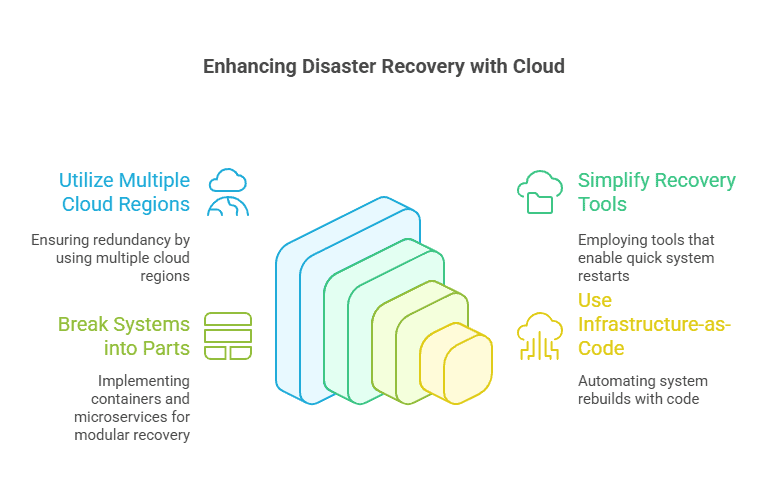Baton Rouge Managed IT Services Provider Shares Tips for Stronger Disaster Recovery Planning
Baton Rouge, United States - October 15, 2025 / InfoTECH Solutions, L.L.C. - Baton Rouge Managed IT Services Company /
Baton Rouge MSP Explains Proven Disaster Recovery Strategies
Too many recovery plans fail when it matters most. Despite their best efforts, many business leaders think they’re ready for a disaster because they invested in a basic recovery plan. Too often, these plans come from templates; they don’t match how a company’s systems or teams work in real-time. That leads to real problems when something goes wrong.
If the right disaster plan isn’t in place, 40% to 60% of small businesses that lose access to critical systems and data end up closing permanently.
Brian Leger, Co-Founder of InfoTECH Solutions, puts it this way, “A great disaster recovery plan isn’t just about technology. It’s about planning for critical emergencies you can’t predict but have the potential to wreck your business.”
In this blog from a reliable managed IT services provider in Baton Rouge, you’ll learn disaster recovery best practices that help you avoid common failures. You’ll walk away with real steps to improve your plan and protect your business.
Why Disaster Recovery “Best Practices” Still Fail For Many Businesses
58% of data backups fail during recovery, leaving businesses vulnerable to permanent data loss and costly downtime. Many businesses don’t realize their plans aren’t what they need until it’s too late. Most plans are out of date, too simple, or missing key parts.
Below are some common reasons established recovery efforts fail.
- Old recovery plans: Many companies create a plan once and never update it. These plans no longer match their systems or business processes.
- Backups in one location: If backups are stored in the same place as your systems, both can be lost in a disaster.
- No communication strategy: If staff don’t know who to call or what to do, even a good plan won’t help.
- No plan for new threats: Many older plans don’t address ransomware, cloud outages, or modern cyberattacks.
These issues can cause confusion and long delays. Each one needs to be fixed in your current plan.
Rebuild Your Strategy with Disaster Recovery Best Practices Built for Today
Your disaster recovery strategy should match your systems, your staff, and your business needs. They should also address evolving technologies, such as cloud computing, remote work, and AI. These best practices for disaster recovery help you do that.
- Set clear RTO and RPO: RTO tells you how fast systems must come back online. RPO tells you how much data you can lose. These numbers should reflect actual risks.
- Focus on applications: Start recovery with the tools people use every day—not just servers and hardware.
- Prioritize critical systems: Identify the systems that keep your business running. Recover those first to reduce impact.
- Automate with checks: Automate where it makes sense, but always monitor. Use alerts to track steps and results.
- Separate failover and failback: Your data center disaster recovery plan should explain how to switch to backup systems and how to return to normal later.
Communication Best Practices for Disaster Recovery: Defining Roles and Responsibilities
During a disaster, confusion slows everything down. Your team needs to know exactly what to do and who is responsible.
- Disaster declaration: Name the person with the authority to call a disaster and start the recovery plan.
- Backup leaders: If the main contact is unavailable, others should be trained to take over right away.
- Escalation coverage: Create a schedule that shows who is on call at all times. Include nights, weekends, and holidays.
- Know what vendors do: Be clear about what your IT partners and service providers will handle, and what they won’t.
Bring Incident Response and Disaster Recovery Into One Coordinated Workflow
Recovery and incident response are often separate, but they shouldn’t be. Connecting them speeds up recovery.
- Connect alerts to action: If a threat such as ransomware is detected, your disaster recovery should begin immediately.
- Begin recovery early: You don’t need to wait for a full investigation. Recovery and analysis can happen at the same time.
- Test as one plan: When you run a drill, include incident detection, communication steps, and full recovery in the same test.
Test Smarter, Not Harder
23% of businesses never test their disaster recovery plans, and another 27% test them only once a year or less. You can’t trust a recovery plan you haven’t tested. Many businesses only do light testing that doesn’t match real conditions.
- Go beyond tabletop drills: Talking through a plan isn’t enough. You need to see what happens under real pressure.
- Use real systems for testing: Try recovery in a test environment that closely matches your live setup. Include full data and user access.
- Test small events too: Many disasters affect only part of your systems. Include scenarios like slow performance or partial data loss.
- Score every drill: After each test, document what worked and what didn’t. Use the results to fix issues right away.
Build for Resilience With A Cloud-First Disaster Recovery Mindset

- Use multiple cloud regions: Don’t rely on one data center or cloud region. If one goes down, another should take over.
- Simplify recovery tools: Don’t just clone virtual machines. Use recovery tools that are quick to restart.
- Break systems into smaller parts: Containers and microservices let you restart parts of an app instead of waiting for everything.
- Use code to rebuild: Infrastructure-as-code lets you rebuild entire systems quickly and with fewer errors.
Document Everything Where It Can’t Be Lost
If your team can’t find the plan, it doesn’t matter how good it is. Make sure everything is easy to access and up to date.- Use online storage: Keep your recovery plan in a secure cloud location. Avoid saving it only on office computers.
- Link to everything needed: The plan should include direct links to credentials, contact lists, scripts, and any other tools.
Review and Refine Your Disaster Recovery Strategy Quarterly
Don’t wait until the end of the year to update your recovery plan. Make it part of your regular routine.- Use test results to improve: Every test should lead to updates. Change steps, tools, or roles based on what you learn.
- Track system changes: If your business adds new apps or vendors, update the plan right away.
- Train every new hire: Make recovery part of your onboarding. Everyone should know what to do during downtime.
Fix Weak Points in Your IT Strategy With DR Best Practices
Even strong plans can fail if small details are overlooked. This table shows common gaps and how to close them.
| Weak Point | Impact | How to Fix |
| No clear disaster authority | Delays the start of recovery | Assign named leaders |
| Outdated contact list | Missed handoffs or confusion | Update contact info every quarter |
| On-prem only backups | Data lost during site-wide events | Add cloud-based or off-site backups |
| No test of partial recovery | Missed app dependencies | Run small-scope DR tests regularly |
| Too many manual steps | Slower, error-prone recovery | Use scripts and tools to automate |
Don’t Wait Until You Fail – Implement DR Best Practices With a Trusted Baton Rouge Managed Services Provider
These disaster recovery best practices show what it takes to build a plan that works in real-life conditions. Most plans miss key steps. We help you fix that.
InfoTECH Solutions has supported Louisiana businesses for over 17 years. We’re MSP Verify™ certified, A+ rated by the BBB, and registered with the state as an MSP vendor. From offices in Lafayette and Jennings, we serve SMBs across the I-10 corridor.
Our team offers fully managed data center disaster recovery services with 24×7 monitoring, tested backup systems, and expert support. We help businesses meet HIPAA and insurance compliance and respond faster during outages or ransomware threats.
Let’s review your current plan. We’ll help you close the gaps and make sure your recovery process holds up when it matters most.
Contact a trusted Baton Rouge managed IT services provider to review your recovery strategy. Let’s make sure your plan holds up when it counts.

Contact Information:
InfoTECH Solutions, L.L.C. - Baton Rouge Managed IT Services Company
9800 Airline Highway Suite 221, East Entrance, 2nd Floor
Baton Rouge, LA 70816
United States
Brian Leger
(833) 390-0979
https://infotech.us/
Original Source: https://infotech.us/disaster-recovery-best-practices/


